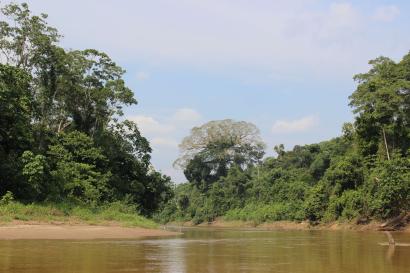
The view from my backyard in Cumbayá, a suburb of Quito.
On the first day of ornithology class last spring, my wise professor stood in front of the blackboard and told us why he studies birds. Though the notebook in which I eagerly scribbled the semester’s notes is at home in the Northern Hemisphere, some of his words have stayed with me: a knowledge of birds can provide you with grounded self-awareness in a world where everything else melds into one. Globalization and accessible transportation lets you fly across the continent in a matter of hours and forget that you traveled at all. Maybe you step off the plane into a concrete city that looks just like your own, or walk right into an air-conditioned building and lose sight of your sudden change in latitude. Maybe you forget how big the world is and just how small you are. But then, an amateur ornithologist in a business suit, you look out the window and see a sparrow with a feathery tuft on his unfamiliar little head, and you remember the thousands of miles that separate you and the bird outside from his sparrow cousins at home. You remember the valleys and rivers and mountain ranges that you just flew over, the ones that perhaps prompted the speciation of the same songbirds millions of years ago. And suddenly, thanks to a foreign sparrow, you are a bit more present, a bit less oblivious to the world outside.
A few days ago, I awoke to find that I was not swaddled in seventeen quilts. It was 6:30am, light streamed in through the window above my new bed, and I was utterly confused. I rose to get my first daylight glimpse of Ecuador, and was met with a surprise that left me glued to the windowpane, blinking in the sun, staring at the familiar plant growing wildly along the stucco wall outside. Lantana camara happens to be one of the few tropical plants that I’m familiar with. Its flowers, which grow in clusters of variegated pinks and yellows and smell like sugar-coated orange slices, attract butterflies with their sweet nectar. Here, Lantana blooms in the sun along mountainsides, roadsides, and up telephone poles. It’s everywhere. I stared and I knew that three-thousand miles North, in the greenhouse of my New England college, they were growing the plant between protective glass walls, pumping heat at its buds and begging it to bloom.
see pt. 2

Grace Glynn
<p><span style="color: rgb(29, 29, 29); font-family: Arial, Verdana, sans-serif; font-size: 12px; line-height: normal; background-color: rgb(237, 237, 237);">Grace is a junior at Connecticut College with a major in botany. She grew up on the coast of Maine and looks forward to leaving its harsh winter for the equatorial Galapagos Islands. Grace’s interests include paleontology, backpacking, folk music, and fermented foods. Join her as she heads to Ecuador for the semester!</span></p>






